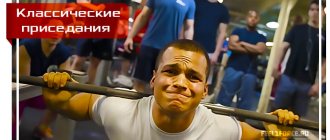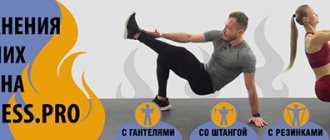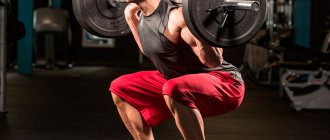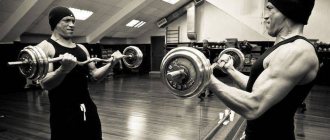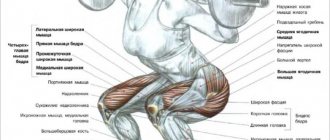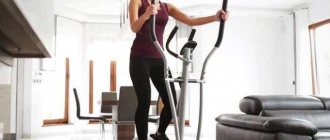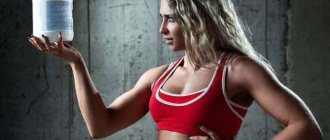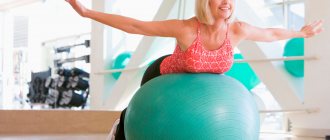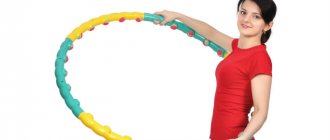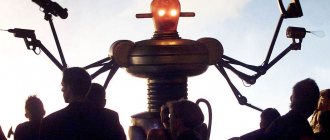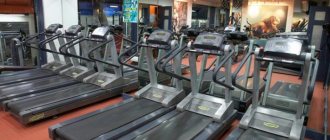Goblet squats or goblet squats are a basic exercise for the legs, buttocks, and abs. This movement involves the entire body, the arms work statically. But this is not the only value of the goblet. Exercise is the only option in which it is possible to learn to work with a relatively straight back and in full amplitude. The movement is used in practice to “cure” shortness of breath in beginners, and teach them how to properly work their knees, ankles and back. In fitness, the movement is shown up to parallel, but this option is performed only by those whose knees do not bend for anatomical reasons.
What it is
Goblet means "cup" in English. The athlete's arm movements are reminiscent of holding a cup in front of him when he tries to perform a squat. Goblets are common not only in strength training, but also in functional training as a movement for the core, glutes and legs.
The following are used as weights:
- 1 dumbbell;
- 1 or 2 weights;
- Barbell pancake;
- Sandbag;
- Handy weights - bottles with water and sand
The advantage of the exercise is its versatility. To work out your legs and buttocks, you don't need to go to the gym. Keeping your weight in front of you teaches you how to position your chest and torso correctly. The exercise increases the mobility of the knee and hip joints, and helps get rid of posture problems in the squat.
The exercise is accessible to beginners, since the weight can be selected to a minimum. Various variations are possible to make the movement more challenging - adding rubber shock absorbers under the knees or on the hips will help engage the buttocks.
The best exercises with kettlebells
As you master the exercises and become more active, increase the weights. Now let's finally move on to the exercises. Let's scroll further!
Swing with two hands
Target muscles: pelvis, hips, arms, shoulders, body.
- Grasp a wide-handled kettlebell with both hands.
- Stand straight with your feet shoulder-width apart.
- Roll your shoulders back, brace your core, look straight, lift the kettlebell in front of you (keep your arms straight) and swing to gain momentum.
- Bend your knees slightly and, using your hips as a fulcrum, tilt your body (no need to squat). The weight should move between your legs by inertia, then return back. On the reverse movement of the kettlebell, straighten up.
Sets and reps
3 sets of 15 reps
Swing with one hand
Target muscle groups are shoulders, buttocks, thighs, arms and core.
- Grab a kettlebell with a narrow handle with your right hand.
- Stand straight with your feet slightly wider than shoulder-width apart. Place your left hand close to your body.
- As with the previous exercise, swing the kettlebell to gain momentum.
- Bend your knees and lower yourself into a half squat. Bend your body at the waist and pass the weight between your legs.
- As you swing, return to the starting position.
- Repeat for the other hand.
What muscles work in the goblet squat?
The main drivers in the exercise are:
- Thigh muscles - biceps and quadriceps;
- Soleus muscle of the leg;
- Gluteal
- The following act as stabilizers of the athlete’s body weight and weights:
- Rectus abdominis muscle;
- Arm biceps, brachialis, anterior deltoids
The movement can also cause stabilization due to tension in the trapezius muscles, but this is not desirable.
When to use
It’s hard to imagine the goblet as the main exercise for a powerlifter or bodybuilder. The weight of the weight used is insignificant; it will not be possible to “pump up” large legs. The exercise is used as an auxiliary exercise in crossfit and kettlebell lifting. It is also used to teach beginners how to squat.
Goblets can become a main movement if performed with additional weights tied to the belt, but this is rarely used in practice.
Goblet squats with a kettlebell: technique [Sports Bro]
The harm of squats
The benefits of squats with kettlebells are undeniable. But sometimes this exercise can be harmful. For example, if you have medical contraindications to putting stress on your knee joints, back, or other parts of the body responsible for distributing the load when squatting, you should consult a specialist. You may have to give up this exercise altogether or choose the optimal load to avoid injury. And of course, if the technique is violated, the harm to joints and muscles is simply colossal. Incorrect distribution of the load, sharp shocks or jerks can reward you with any type of damage: from sprains and dislocations to serious fractures. That is why it is better to practice the squatting technique under the supervision of an instructor.
Training for beginner bodybuilders
If you immediately put a beginner under the barbell, there is a big risk that he will not understand the mechanics of the movement. The skill of keeping your back vertical and lifting through your hips, rather than by pulling your buttocks back, comes with experience. The front squat and goblet are more promising in this regard. They help the athlete get rid of mistakes, since it is simply not possible to stand up by lifting the buttocks while holding the weight in front of you.
The second important skill that you gain with the goblet squat is keeping your abs tense and breathing into the anterior abdominal wall. The third is movement by directing the knees towards the noses and bending them, and not by tilting the body forward.
Important: learning to squat with a barbell begins after the athlete learns to perform the movement technically correctly for 10-12 repetitions with a kettlebell or dumbbell. There is no need to delay this moment, as in the future the athlete may have problems with the motor stereotype.
How to Do Squats, Deadlifts, and Lunges to Target Your Glutes
These exercises are not as effective as the ones above. But if you don't have time and need to hit your entire lower body at once, simply change the position of your legs and shift the emphasis to the buttocks.
Squats
Perform sumo squats: place your feet twice as wide as your shoulders, pointing your toes out to the sides.
If you are performing a squat with a plate or dumbbells, extend the apparatus in front of you. This way you will increase the abduction of the pelvis back and strengthen the development of the buttocks.
Deadlift
Do sumo deadlifts: with your feet wide and your toes turned out to the sides. This will only slightly increase the load on the buttocks, but it’s still better than nothing.
Lunges
During lunges, lean your body forward.
Place your feet at the top of the platform, spread your legs wider and point your toes out to the sides.
Home workouts
The reasons why a person chooses home training are free and convenient. There is no need to go to the other end of the city and pay for the hall. Home workouts are only as effective as a person knows the technique of the exercises and can do them independently with sufficient self-discipline.
At home, you need to perform a large volume of training load, since this is the only way to get an active effect on the muscles. But training of this kind will only increase strength endurance, and not muscle volume.
Women's fitness and bodybuilding
Exercise will help tone your muscles and increase your overall endurance. In scientifically based training regimens for women's fitness, the goblet is given for 1-2 introductory months, and after that the client performs more difficult exercises, such as leg presses and squats with a barbell.
But in women's fitness, volume often prevails over intensity, so many remain at the level when the goblet is performed as the main exercise. This is not optimal, but it happens in practice with clients who do not want to have bulky muscles, and for whom just tone is enough.
Practice shows that goblet can be performed with a weight of up to half of your own body weight, but more often than not, girls stop at a third of their own body weight. This allows you to get an adequate load on the muscles, but does not lead to their significant hypertrophy.
Women's training for many is built around pumping up the buttocks. Most people don't want to have developed quadriceps muscles. A deep goblet squat is capable of maximizing the involvement of the buttocks in the work.
Goblets in women's fitness are also used as an exercise to pre-fatigue the quadriceps. There is no scientific basis for this idea, but many believe that if you first perform several sets of goblet squats, and then do heavy glute exercises, the quadriceps will magically shut down. In fact, it all depends on the selection of heavy exercises. If by this you mean a classic squat with a barbell, nothing will come of it. It’s the same with other types - sumo squats, dumbbell squats, and hack machine squats. For normal harmonious development of the body, it is advisable to use the technique in combination with traction.
Goblet squats for girls
Anatomical features
The buttocks are formed by three posterior muscles - large, medium, small.
Each performs its specific function. The large one is used when moving the legs to the sides and back, while straightening the torso, and occupies the largest area of the buttocks. The small one is located directly under the large one. Together with the middle one, they work only when the leg is abducted to the left and to the right. The gluteus maximus muscle is most active during body extension. A similar load can be caused by doing:
- squats with weights - dumbbells or barbells;
- lunges;
- Romanian and deadlift;
- bending when a barbell rests on your shoulders.
Medium and small are involved in work when:
- swing your leg while lying on your side and from the lower block to the sides;
- leg extensions in a sitting machine;
- abducting the legs from a standing position with the machine lever.
Execution technique
Technically correct execution of the exercise is only possible with adequate weight. Kettlebell fitness experts recommend that women start with a weight of 8 kg, and men - 16 kg. It makes no sense to use smaller projectiles, since the core cannot be used with them.
Classic version
The most difficult thing here is taking the projectile in the stance. The tilt is performed by flexing the hip joint, and the athlete grasps the kettlebell or dumbbell with both hands on both sides. Then, due to extension in the pelvis with slightly bent knees, the weight is placed on the chest. It is important to “substitute” your chest under the weight so that it loads the center of the body, and is not just held by your hands. During the lift, the back is tense, the shoulder blades are brought towards the spine, the abs are tightened.
After capture comes stabilization. You should not immediately bend your knees and sit down. The athlete must stabilize the center of the body so that the weight rests firmly on his chest and does not slide. The point is to redistribute the weight between the body and arms so that the athlete does not overexert himself and does not squeeze the weight with his hands. This is an important skill, it is practiced separately. If you don’t work it out, you won’t be physically able to lift a normal weight of weight onto your chest.
After stabilizing the weight, you need to place your feet so that the heels are slightly wider than the pelvic bones, approximately at the level of the middle delta. The toes of the feet are spread to the sides, as convenient as possible. The athlete bends the knee and hip joints, and at the same time drives the knees towards the toes.
Important: you can often see how trainers encourage their clients to make a technical mistake - bending the body forward. This is a rather traumatic position for the knee, and no particular benefit can be obtained. In “folk beliefs” such a squat with an inclination and under-squatting has taken root as “female”. But in fact, it is simply technically incorrect; the quadriceps works perfectly even with incomplete amplitude in the knee joint, despite the fact that many try to “turn off” it due to this position.
The bottom of a squat is the point at which the pelvis drops below the knee. Ideally, the thigh is in full contact with the shin. Achieving such depth should only be achieved by those athletes who can avoid the “pelvic dive,” that is, turning the pelvis at the bottom of the squat in the opposite direction.
This option allows you to fully stretch your gluteal muscles and use them to start from the bottom. The buttocks contract, the impulse is transmitted to the thigh muscles, the knee and hip joints extend. The goblet should be one, unified movement, in which there is no room for tilting the body, or moving the pelvis upward due to active contraction of the back muscles and upward thrust of the hips.
The point of the exercise is to keep the projectile in front of your chest at all times. Other implementation options are not allowed.
Goblet Squat / Goblet Squats. Crossfit
Sumo option
The goblet squat in sumo refers to the same movement with very wide feet. So much has not been written about its benefits. Some people believe that this way the quadriceps are turned off from work, but in fact, this option does not turn off the quadriceps, but simply leads to the fact that the adductor muscles of the thigh are included in the work. Therefore, those who are afraid to pump themselves up at least something should pay attention to this valuable information.
The sumo variation requires significant flexibility and mobility in the hip joint. The athlete takes a wide stance, knees pointing almost to the sides, feet turned out strongly. The movement of the knee joint is in the same direction as the toes, that is, not in a plie, but in a slightly smaller angle. It is advisable to lower the buttocks below the knee joint.
The movement is considered beneficial for the development of the gluteus medius muscle, since pushing out the weight occurs due to the contraction of this particular muscle.
Important: if after performing the movement there is pain in the joints, you should abandon sumo.
Set of exercises
To avoid injury, you first need to warm up your muscles, ligaments and joints very well. Set aside 5-10 minutes for a general warm-up.
Take the shell. Warm up with the kettlebell: hold the weight in your hand, make a couple of swing movements, feel the weight and practice a strong grip.
Each exercise should be performed in 2-3 sets of 30-50 repetitions , depending on your level of training.
Kettlebell swings with one hand, alternating
Works: lower back, legs and shoulders, trapezius. Brush and grip - if you don’t alternate, but do it with one hand.
Technique: the back always remains straight, the buttocks are tense, the arms are straight.
One-arm kettlebell snatch
Technique:
1) Starting position – feet shoulder-width apart, knees slightly bent.
2) Grab the handle of the weight not in the middle, but from the side, with an open grip - your wrist facing you.
3) During the swing, slightly straighten your knees. At the moment of the push, do a slight squat. When lifting, keep your back straight, do not lean your body back.
4) At the top point, keep your arm at your side, do not put your elbow behind your head.
Swings
Works: shoulder girdle, back and buttocks.
There are two versions of the exercise of varying complexity: with and without delay at the top point.
Technique:
1) Starting position – feet shoulder-width apart, squat slightly, bend down.
2) Grasp the weight with your hand and straighten your legs.
3) As you lift the kettlebell off the floor, it will swing back slightly. There is no need to hinder this movement. After this, begin to swing forward, fully straightening your body at the extreme point.
4) If desired, you can bring the weight to the very top and hold it above your head for a few seconds. This way you will work the shoulder girdle.
Lateral bends
Works: abdominal muscles.
If you are afraid of “swinging” your waist, try to use your abdominal muscles rather than pulling the weight out with your sides.
Kettlebell push squats
Works: quadriceps, hamstrings, glutes, shoulders and triceps.
